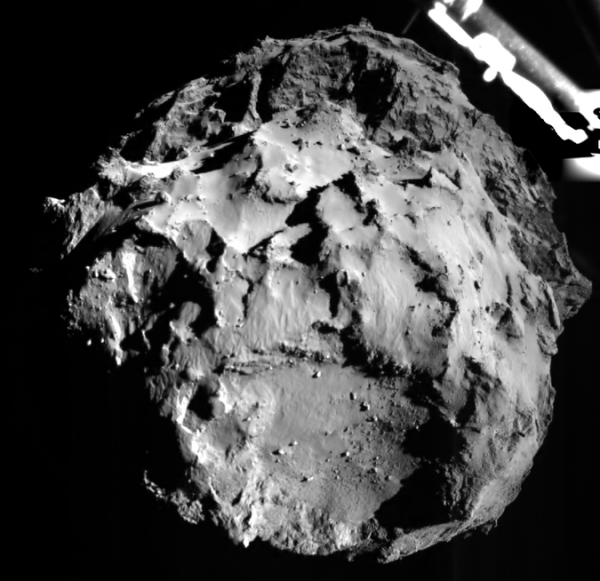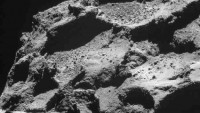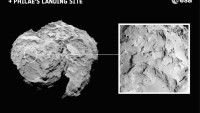Rosetta Philae Probe Successfully Lands On Comet, But Has Anchor Problems
| Dan Weisman | | Nov 12, 2014 09:05 PM EST |
(Photo : European Space Agency) An image taken by the Philae lander as it descended toward the surface of Comet 67P/Churyumov-Gerasimenko.
The European Space Agency's (ESA) robot probe has made the first ever landing on a comet; however, an anchoring mechanism developed difficulties, possibly hampering further exploration.
Named Rosetta, the mission was designed to demystify comets as well as explore the origins of the universe. Almost weightless on the comet surface, the probe, called Philae, needed a seven-hour descent from the Rosetta mother ship to reach the comet that was about 300 miles from Earth.
Like Us on Facebook
Comets represent opportunities for scientists to examine what may reveal the basic building blocks of Earth. Scientists want to learn the extent of melted comets in the world's oceans in an effort to identify how water developed. Some speculated comets brought water to the planet. Another mission benefit stemmed from new technology that may be useful in future attempts to mine asteroids.
The anchoring problem centered on harpoons designed to keep Philae from drifting on the comet's surface. They apparently failed to deploy during the lander's free-fall to Comet 67P/Churymov-Gerasimeko.
The 2.5-mile wide comet, which was first discovered in 1969, moves at 40,000 miles per hour through the black stretches of space. The mission officially took 10 years, five months and four days, costing almost $2 billion.
From ESA's mission control center at Darmstadt, Germany, Jean Jacques Dordain, ESA director general, said Rosetta's ambitious mission "has secured another place in history books." He called the effort "a big step for human civilization."
The comet was the seventh heavenly body with a manmade spacecraft landing. Mars, Venus, Saturn's moon Titan, the moon, two asteroids and comet Tempel-1 are the others.
Tagsphilae, Space, comet, NASA, asteroids, european space agency, rosetta, NASA
©2015 Chinatopix All rights reserved. Do not reproduce without permission
EDITOR'S PICKS
-

Did the Trump administration just announce plans for a trade war with ‘hostile’ China and Russia?
-

US Senate passes Taiwan travel bill slammed by China
-

As Yan Sihong’s family grieves, here are other Chinese students who went missing abroad. Some have never been found
-

Beijing blasts Western critics who ‘smear China’ with the term sharp power
-

China Envoy Seeks to Defuse Tensions With U.S. as a Trade War Brews
-

Singapore's Deputy PM Provides Bitcoin Vote of Confidence Amid China's Blanket Bans
-

China warns investors over risks in overseas virtual currency trading
-

Chinese government most trustworthy: survey
-

Kashima Antlers On Course For Back-To-Back Titles
MOST POPULAR
LATEST NEWS
Zhou Yongkang: China's Former Security Chief Sentenced to Life in Prison

China's former Chief of the Ministry of Public Security, Zhou Yongkang, has been given a life sentence after he was found guilty of abusing his office, bribery and deliberately ... Full Article
TRENDING STORY

China Pork Prices Expected to Stabilize As The Supplies Recover

Elephone P9000 Smartphone is now on Sale on Amazon India

There's a Big Chance Cliffhangers Won't Still Be Resolved When Grey's Anatomy Season 13 Returns

Supreme Court Ruled on Samsung vs Apple Dispute for Patent Infringement

Microsoft Surface Pro 5 Rumors and Release Date: What is the Latest?













